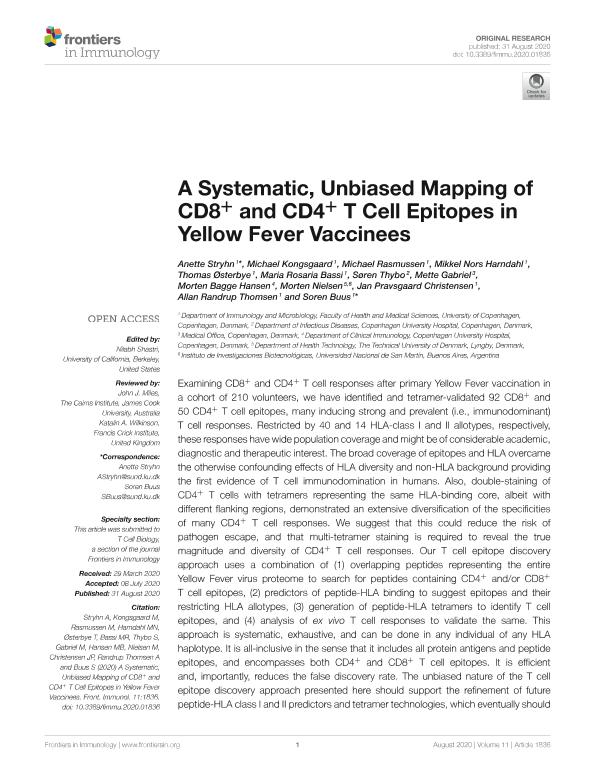Mostrar el registro sencillo del ítem
dc.contributor.author
Stryhn, Anette

dc.contributor.author
Kongsgaard, Michael
dc.contributor.author
Rasmussen, Michael
dc.contributor.author
Harndahl, Mikkel Nors
dc.contributor.author
Østerbye, Thomas
dc.contributor.author
Bassi, Maria Rosa
dc.contributor.author
Thybo, Søren
dc.contributor.author
Gabriel, Mette
dc.contributor.author
Hansen, Morten Bagge

dc.contributor.author
Nielsen, Morten

dc.contributor.author
Pravsgaard Christensen, Jan
dc.contributor.author
Randrup Thomsen, Allan
dc.contributor.author
Buus, Soren
dc.date.available
2021-09-17T12:25:22Z
dc.date.issued
2020-08
dc.identifier.citation
Stryhn, Anette; Kongsgaard, Michael; Rasmussen, Michael; Harndahl, Mikkel Nors; Østerbye, Thomas; et al.; A Systematic, Unbiased Mapping of CD8+ and CD4+ T Cell Epitopes in Yellow Fever Vaccinees; Frontiers Media S.A.; Frontiers in Immunology; 11; 8-2020; 1-40
dc.identifier.issn
1664-3224
dc.identifier.uri
http://hdl.handle.net/11336/140640
dc.description.abstract
Examining CD8+ and CD4+ T cell responses after primary Yellow Fever vaccination in a cohort of 210 volunteers, we have identified and tetramer-validated 92 CD8+ and 50 CD4+ T cell epitopes, many inducing strong and prevalent (i.e., immunodominant) T cell responses. Restricted by 40 and 14 HLA-class I and II allotypes, respectively, these responses have wide population coverage and might be of considerable academic, diagnostic and therapeutic interest. The broad coverage of epitopes and HLA overcame the otherwise confounding effects of HLA diversity and non-HLA background providing the first evidence of T cell immunodomination in humans. Also, double-staining of CD4+ T cells with tetramers representing the same HLA-binding core, albeit with different flanking regions, demonstrated an extensive diversification of the specificities of many CD4+ T cell responses. We suggest that this could reduce the risk of pathogen escape, and that multi-tetramer staining is required to reveal the true magnitude and diversity of CD4+ T cell responses. Our T cell epitope discovery approach uses a combination of (1) overlapping peptides representing the entire Yellow Fever virus proteome to search for peptides containing CD4+ and/or CD8+ T cell epitopes, (2) predictors of peptide-HLA binding to suggest epitopes and their restricting HLA allotypes, (3) generation of peptide-HLA tetramers to identify T cell epitopes, and (4) analysis of ex vivo T cell responses to validate the same. This approach is systematic, exhaustive, and can be done in any individual of any HLA haplotype. It is all-inclusive in the sense that it includes all protein antigens and peptide epitopes, and encompasses both CD4+ and CD8+ T cell epitopes. It is efficient and, importantly, reduces the false discovery rate. The unbiased nature of the T cell epitope discovery approach presented here should support the refinement of future peptide-HLA class I and II predictors and tetramer technologies, which eventually should cover all HLA class I and II isotypes. We believe that future investigations of emerging pathogens (e.g., SARS-CoV-2) should include population-wide T cell epitope discovery using blood samples from patients, convalescents and/or long-term survivors, who might all hold important information on T cell epitopes and responses.
dc.format
application/pdf
dc.language.iso
eng
dc.publisher
Frontiers Media S.A.

dc.rights
info:eu-repo/semantics/openAccess
dc.rights.uri
https://creativecommons.org/licenses/by-nc-sa/2.5/ar/
dc.subject
CD4+ AND CD8+ T CELL EPITOPE DISCOVERY
dc.subject
FORWARD-REVERSE IMMUNOLOGY
dc.subject
IMMUNODOMINANCE AND IMMUNODOMINATION
dc.subject
IMMUNOGENICITY
dc.subject
PEPTIDE-MHC PREDICTORS
dc.subject
PEPTIDE-MHC TETRAMERS
dc.subject
YELLOW FEVER VACCINATION
dc.subject.classification
Otras Ciencias de la Salud

dc.subject.classification
Ciencias de la Salud

dc.subject.classification
CIENCIAS MÉDICAS Y DE LA SALUD

dc.title
A Systematic, Unbiased Mapping of CD8+ and CD4+ T Cell Epitopes in Yellow Fever Vaccinees
dc.type
info:eu-repo/semantics/article
dc.type
info:ar-repo/semantics/artículo
dc.type
info:eu-repo/semantics/publishedVersion
dc.date.updated
2021-08-25T19:40:03Z
dc.journal.volume
11
dc.journal.pagination
1-40
dc.journal.pais
Estados Unidos

dc.description.fil
Fil: Stryhn, Anette. Universidad de Copenhagen; Dinamarca
dc.description.fil
Fil: Kongsgaard, Michael. Universidad de Copenhagen; Dinamarca
dc.description.fil
Fil: Rasmussen, Michael. Universidad de Copenhagen; Dinamarca
dc.description.fil
Fil: Harndahl, Mikkel Nors. Universidad de Copenhagen; Dinamarca
dc.description.fil
Fil: Østerbye, Thomas. Universidad de Copenhagen; Dinamarca
dc.description.fil
Fil: Bassi, Maria Rosa. Universidad de Copenhagen; Dinamarca
dc.description.fil
Fil: Thybo, Søren. Universidad de Copenhagen; Dinamarca
dc.description.fil
Fil: Gabriel, Mette. No especifíca;
dc.description.fil
Fil: Hansen, Morten Bagge. Universidad de Copenhagen; Dinamarca
dc.description.fil
Fil: Nielsen, Morten. Consejo Nacional de Investigaciones Científicas y Técnicas. Centro Científico Tecnológico Conicet - La Plata. Instituto de Investigaciones Biotecnológicas. Universidad Nacional de San Martín. Instituto de Investigaciones Biotecnológicas; Argentina
dc.description.fil
Fil: Pravsgaard Christensen, Jan. Universidad de Copenhagen; Dinamarca
dc.description.fil
Fil: Randrup Thomsen, Allan. Universidad de Copenhagen; Dinamarca
dc.description.fil
Fil: Buus, Soren. Universidad de Copenhagen; Dinamarca
dc.journal.title
Frontiers in Immunology
dc.relation.alternativeid
info:eu-repo/semantics/altIdentifier/doi/http://dx.doi.org/10.3389/fimmu.2020.01836
dc.relation.alternativeid
info:eu-repo/semantics/altIdentifier/url/https://www.frontiersin.org/articles/10.3389/fimmu.2020.01836/full
Archivos asociados
